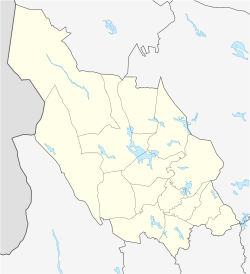|
Grängesberg
Grängesberg (Swedish pronunciation: [ˈɡrɛ̂ŋːɛsˌbærj])[2] is a locality situated in Ludvika Municipality, Dalarna County, Sweden, with 3,481 inhabitants in 2010.[1] The town was dominated by iron-ore extraction at Grängesberg ore field (Grängesbergs malmfält) from the 16th century to 1989.[3] In January 1990 was the last ore-train from Grängesberg to Oxelösund. Attempts to separate apatite from the ore begun in 1928 but were more clearly successful from the late 1930s to 1953.[4] Aparite was separated by "soap flotation" (Swedish: tvålflotation).[4] Grängesbergsbolaget had during a long period the world's largest iron-ore fleet[clarification needed] and by 1899–1900 was it Sweden's most profitable company[clarification needed]. During this time Grängesberg grew very fast, and during a 10-year period the town's population increased threefold. Today Spendrups is Grängesberg's biggest employer. The area is known for its Railway Museum of Grängesberg. It is the birthplace of Erik Lundqvist, a javelin thrower & the 1st person to break the 70m Barrier by 1m Riksdag elections
References
|
||||||||||||||||||||||||||||||||||||||||||||||||||||||||||||||||||||||||||||||||||||||||||||||||||||||||||||||||||||||||||||||||||||||||||||||||||||||||||||||||||||||||||||||||||||||||||||||||||||||||||||||||||||||||||||||||||||||||||||||||||||||||||||||
Portal di Ensiklopedia Dunia


